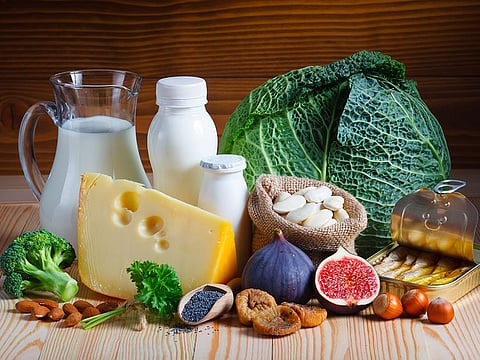Brittle bones – and how to prevent them
This World Osteoporosis Day, here's how diet can help reduce the risk of the disease

Worldwide, one-third of all women and one-fifth of all men over the age of 50 will suffer from an osteoporotic fracture, according to the International Osteoporosis Foundation (IOF). But it doesn’t have to be that way. Diet and exercise play a significant role in preventing the brittle bones that are the hallmark of the disease.
Osteoporosis, which literally means porous bone, is a skeletal disease characterised by low bone mass and disrupted bone architecture. The disease weakens bones, so they break easily – often as a result of a minor fall or bump, a sneeze or even a sudden movement.
World Osteoporosis Day, observed on October 20 each year, aims to draw attention to the condition. Osteoporosis is often called the silent disease because there are no visible symptoms. While not everybody who has the disease may break their bones, when fractures do happen, they can be life-threatening and cause chronic pain or severe long-term disability.
“Women are four times as likely to develop osteoporosis than men and those over 40 are most at risk,” says Dr Osman Laban, Head of Family Medicine at Al Zahra Hospital Dubai. “Furthermore, the older you grow the higher your risk of osteoporosis. Other risk categories include those with a family history of osteoporosis and those who have had previous bone trauma or other comorbidities such a rheumatoid arthritis.”
Our bones are at their densest in our twenties, with peak bone mass declining over time. As we grow older, our bone cells begin to dissolve and are slowly replaced by new cells. Osteoporosis develops when bone loss outpaces the growth of new bone. It is thought to be caused by a lifelong lack of calcium as well as a drop in oestrogen levels. Certain prescription medications and other factors such as smoking are also high-risk factors for osteoporosis.
The disease causes bones to become porous, brittle, and prone to fracture. Women and men of all ethnic groups are affected. Family members often carry the burden of care and the disease affects multiple generations of the family, the IOF says.
“The poor intake of a number of elements or the poor utilisation thereof leads to bone weakness and by extension, osteoporosis,” says Mehfuza Haffiz, a Senior Clinical Dietitian at Dubai Health Authority (DHA). These elements include inorganic minerals such as calcium, magnesium, phosphorus, sodium and potassium, and vitamins and trace elements such as the vitamins A, D, E, K, C, and certain B vitamins, as well as fatty acids and certain proteins. “Therefore, lifestyle and a balanced diet are among the first elements to prevent the risks of bone fractures.”
Overall, Dr Laban explains, the best foods to eat are dark, leafy greens and low-fat dairy, because they are high in calcium, as well as fatty fish, and any foods that are high in fibre, such as fruit and vegetables.
“To reduce your risk of osteoporosis, avoid processed foods, fast foods, canned foods and high amounts of salt and sugar. Most of these foods have high levels of sodium, which deprive bone development and regeneration. A diet high in processed sugars causes the urinary excretion of calcium and magnesium. The key to a healthy life is a balanced diet. We as doctors cannot repeat this enough. This will help with any health condition.”
Exercise is also particularly beneficial to maintain bone strength, Haffiz says. “Consider weight training, walking, hiking, jogging, climbing stairs, tennis, and dancing.”
Finally, if you have osteoporosis, avoid activities that involve twisting your spine or bending forward from the waist, such as conventional sit-ups, toe touches, or swinging a golf club, she adds. “Treating osteoporosis means stopping the bone loss and rebuilding bone to prevent breaks. Healthy lifestyle choices such as proper diet, exercise, and medications can help prevent further bone loss and reduce the risk of fractures.”
Sign up for the Daily Briefing
Get the latest news and updates straight to your inbox



